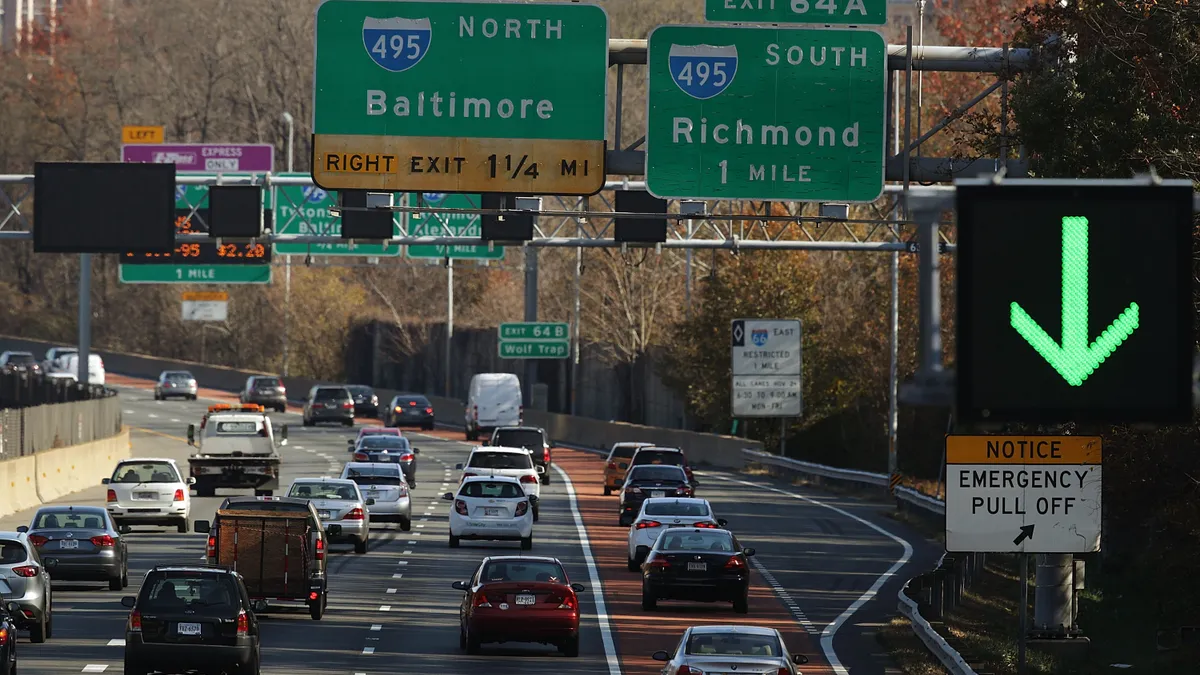Dive Brief:
- A recently overhauled stretch of Interstate 66 in Northern Virginia will fully reopen by the end of the month, featuring three regular lanes, two managed lanes in each direction, and improved interchanges, said Nancy Smith, corporate affairs director at the consortium in charge of construction.
- The project is also the first roadway to use a vehicle-to-infrastructure system developed by Ferrovial — a Cintra subsidiary — to support self-driving vehicles, according to Cintra, part of the I-66 Express Mobility Partners Company joint venture that also includes infrastructure companies Meridiam, John Laing Plc and APG.
- “Infrastructure-based sensing and [vehicle-to-everything] communication will enhance the on-board capabilities of connected and autonomous vehicles and will allow them to operate more safely and effectively than they could do on their own,” said Adrian Talbot, head of the Centre of Excellence for Mobility at Ferrovial, in an email.
Dive Insight:
The expanded highway stretches more than 25 miles between Interstate 495 — known as the Capital Beltway — and Gainesville, Virginia. It will allow an additional 2,000 to 4,000 people to travel through the corridor each hour, Cintra said in a document describing the project. A nine-mile section of the project opened in September, Smith said.
Greater road capacity and managed lanes are crucial to reducing traffic congestion, said Susan Shaw, director of megaprojects for the Virginia Department of Transportation’s Northern Virginia District.
“Managed lanes provide a faster, more reliable trip by adjusting the toll rate upward and downward based on congestion with the goal of maintaining a minimum speed in the toll lanes,” according to Cintra. “The toll rate is posted, so the driver is aware of the rate before making a choice to use the managed lanes. As demand increases, the toll rate increases in order to maintain a reliable trip speed within the managed lanes.”
I-66 Express Mobility Partners invested more than $3.5 billion in the project, which kicked off in 2016. That includes $2.3 billion for the highway expansion and vehicle-to-infrastructure, or V2I system, $500 million for additional projects in the corridor and $800 million to expand transit service.
Talbot said that Ferrovial, whose expertise is in highway development and operations, worked with Intel, Microsoft, Capgemini, Telefonica and 3M to develop its V2I solution. Vehicle-to-everything, or V2X, includes V2I and vehicle-to-vehicle technology.
Transportation officials, automakers and researchers have said vehicle-to-infrastructure technology is necessary to adopt driverless vehicles. But it's unclear when such investments will pay off. The auto industry has recently pumped the brakes on autonomous vehicles due to safety concerns and technological hurdles. In addition, a federal court in August upheld the Federal Communications Commission’s decision to reallocate the spectrum previously dedicated to connected vehicle technology, nullifying earlier V2I investments.
Many policymakers and researchers have claimed that dynamic pricing — a type of congestion pricing that adjusts fees based on real-time data instead of having a fixed price — can reduce traffic and pollution by discouraging unnecessary road use and encouraging people to drive at different times or use public transit. But such policies have faced resistance from a range of stakeholders concerned about everything from government overreach to its effects on equity.











